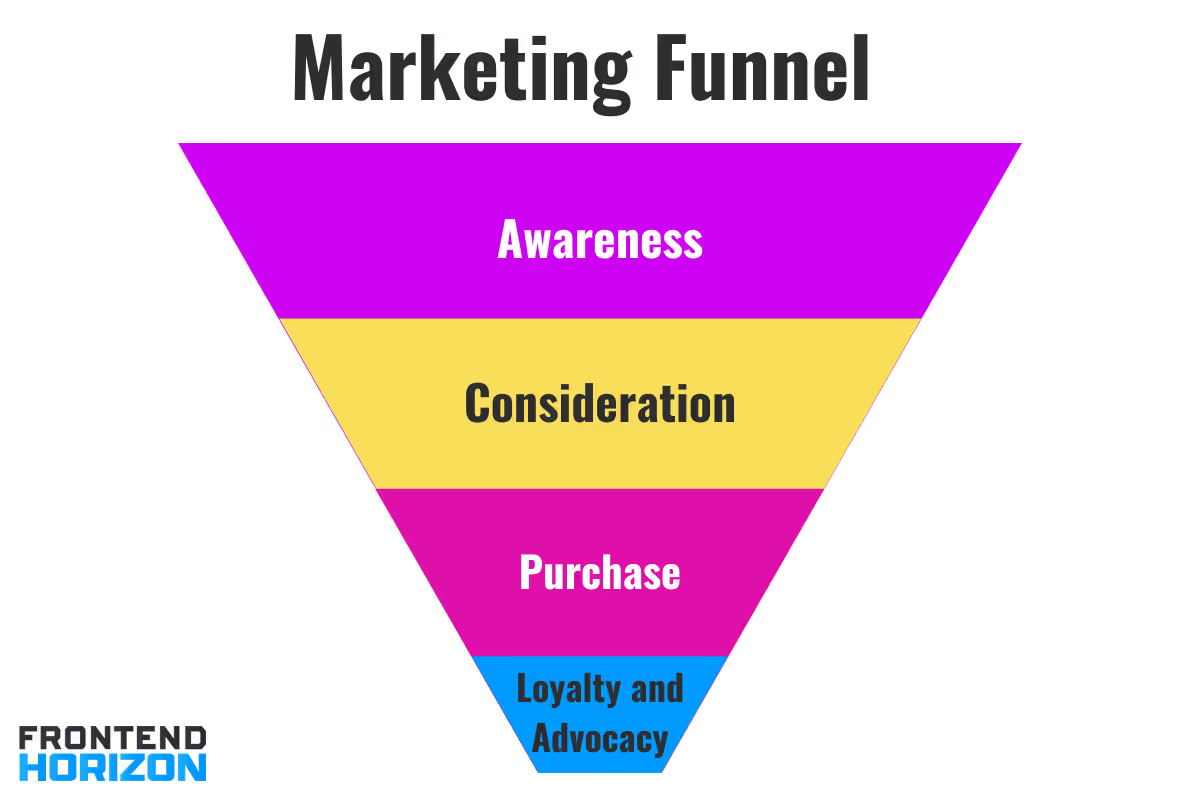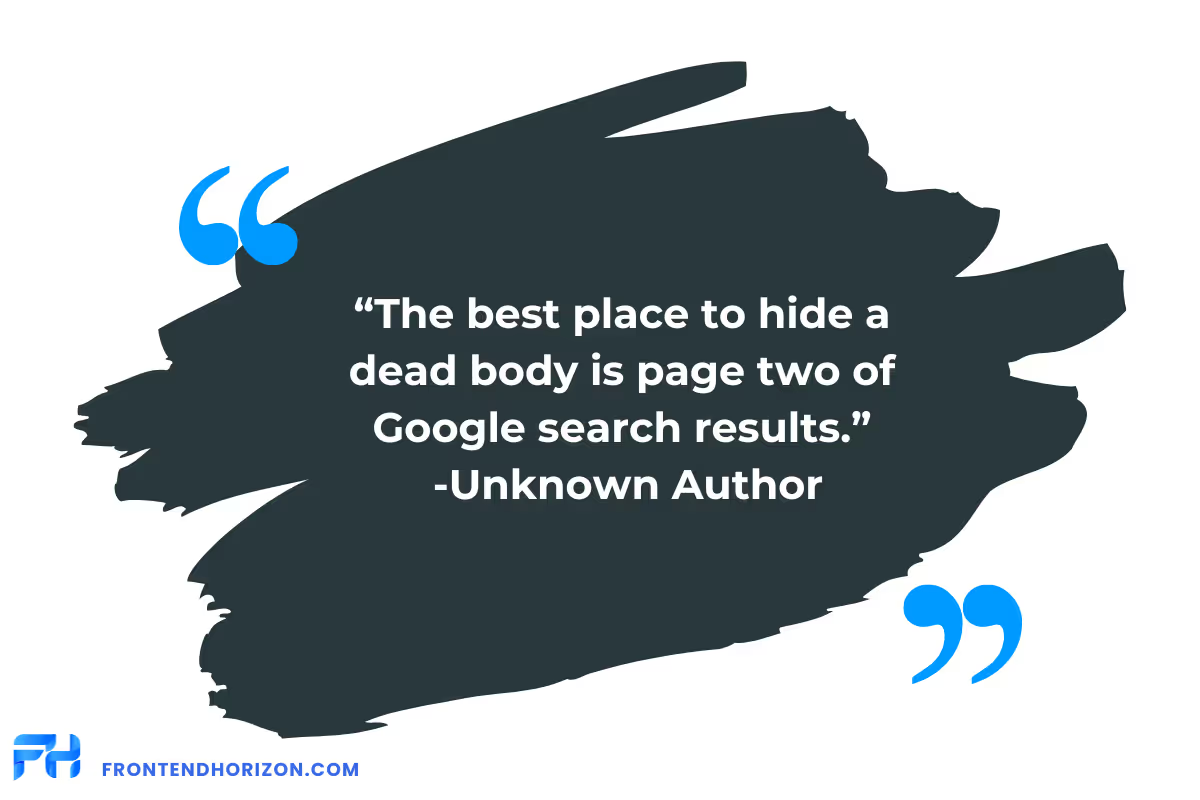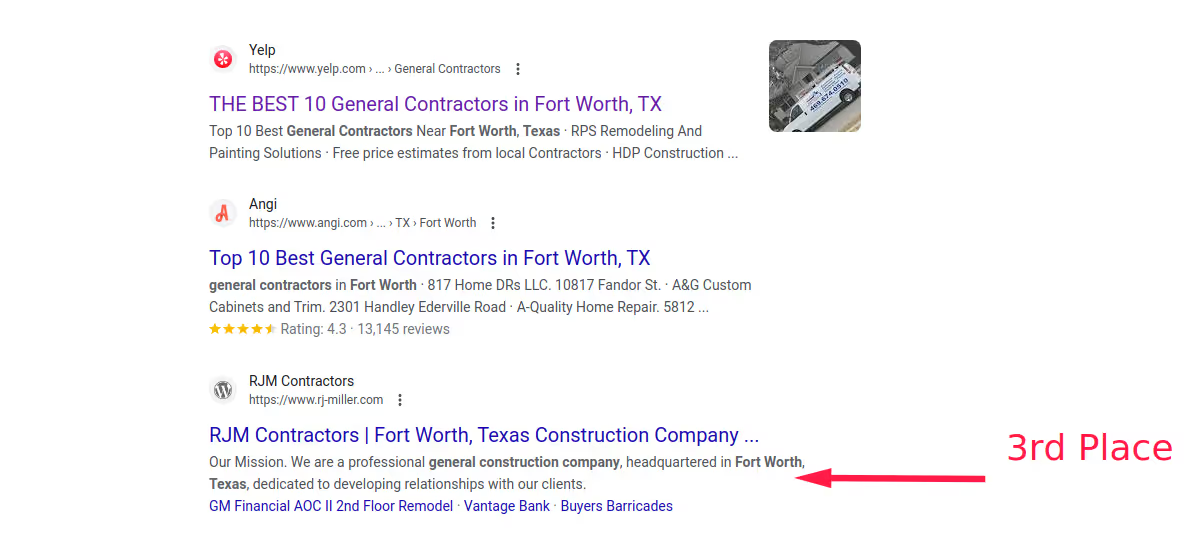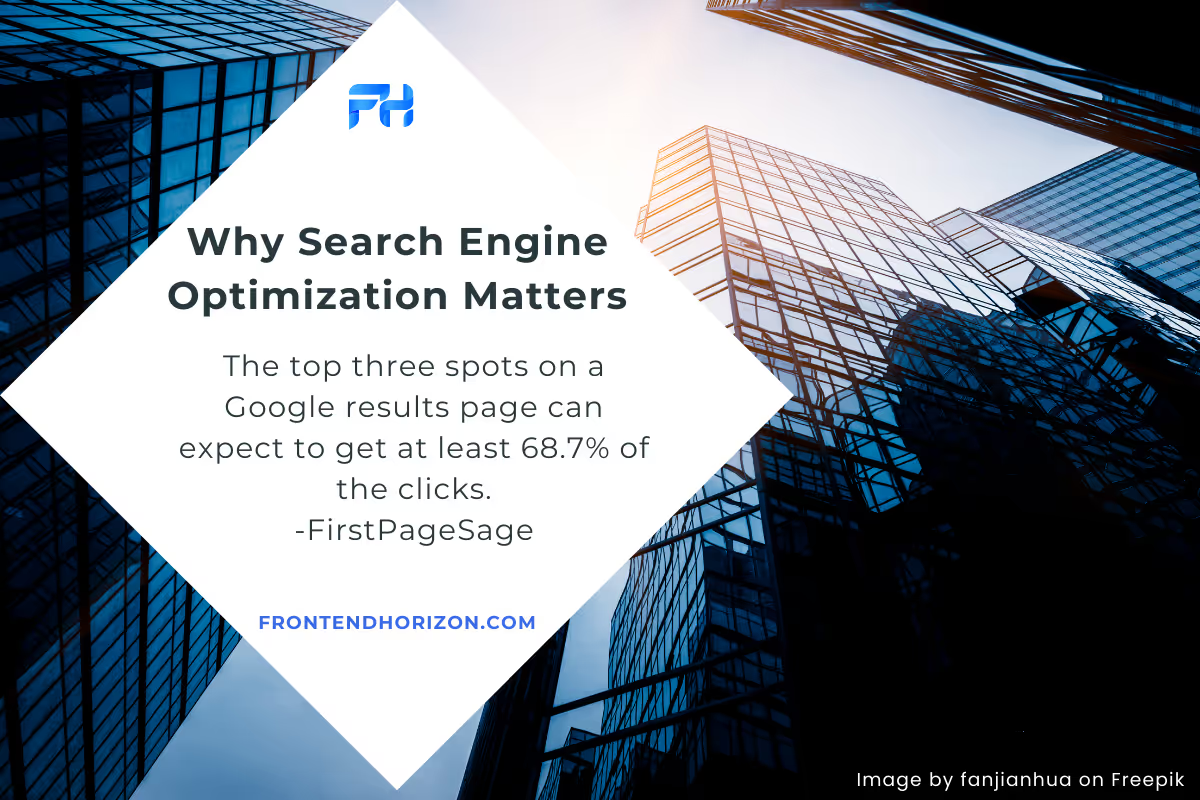Why Search Engine Optimization (SEO) Matters
.svg)
.svg)
Search Engine Optimization (SEO) is a set of techniques to place a website higher on a search engine results page (SERP). Of course, by “search engine” we mean Google since it dominates over 93% of searches (and the world) [1].
The goal of SEO is to be as close to the first result as possible so consumers can find your business. At the very least, you want to land on the first page of local results when someone includes your products, services, or industry in their search query. In order to do this properly, developers should understand what factors search engines work off of. Click here to view our in-depth guide which covers over 200+ ranking factors.
By 2028, SEO is expected to be a 122.11 billion dollar industry[2]. When asked about top marketing challenges, 63% of marketers state their top challenge is “generating traffic and leads”[3] and 61% of marketers place SEO and organic presence as their top marketing priority for getting inbound leads[3].
In this article, we’ll discuss reasons why SEO is a high priority and how it can benefit your business.
SEO & Its Role in Marketing
SEO is a marketing technique that helps with many stages of your marketing funnel. For those who don’t subscribe to marketing jargon, a marketing funnel describes the process a consumer goes through when choosing to buy a product or service (not including regret).

“Awareness” or “Discovery” sits at the top of the funnel. This is when a consumer becomes aware of a product, service, or business. It exists as the first step in a buyer’s journey because it's hard to buy something you don’t know exists without having your credit card stolen beforehand. Only a portion of people will convert to loyal customers, so it is ideal to make the top of your funnel wide while still being specific to your niche [4].
SEO optimizes your top-of-funnel activity by making inbound marketing content (like informational articles in your blog that relate to your industry) discoverable[4]. The focus here is not showing an ad. At that point in the buyer’s journey, the consumer might not be thinking of buying anything. Rather, they might simply be troubleshooting a problem for themselves. When they discover the answers they need via your website, you start to build credibility. You become an option when they do need you.
Next, the middle of the funnel refers to the phase where consumers are considering making a purchase. SEO optimizes your middle-of-funnel activity by leading customers to content that increases the chance of generating leads like how-to guides, product reviews, or case studies[4]. Like content that assists with discovery, these articles are also informational. However, rather than just being useful to a customer, the purpose of these articles is to nudge your lead closer to buying by helping them make an informed decision.
Finally, when someone is ready to buy (bottom-of-funnel before brand loyalty) SEO helps people find your site when they search “{product or service} near me” or “buy {product or service}”[4].
Why SEO Matters - Consumers Start Product Research Online
Most people visit a business online to research products and services before they go in person. A 2019 Google Global Retail Study showed that 83% of in-person shoppers used online searches before their visit[5]. Another survey by Power Reviews showed that 31.5% of respondents start online product research with Google (respondent demographics: 53% Millennials, 29% Gen X, 10% Baby Boomers, 8% Gen Z). This was the second most common research route behind Amazon[6]. The point here is many consumers start their buyer’s journey online. For this reason, it's good to have a Google Business profile and a website that lands high on Google search results.
Why it Matters to be at the Top of Google Search Results

Let’s say you own a general contracting business in Fort Worth Texas. There is a lot of competition. In a 50-mile radius, there are over 7000 businesses that show up when you search “general contractor” on Houzz.com [7].
A potential customer does a local search with “general contractor Fort Worth Texas”. On the top of the first page, they’ll likely see a preview of Businesses registered with Google. I see just three of those 7,000 contractor options. Here they are:

Still on the first page but below that there are many directory websites that list businesses. Amongst a sea of “searchforcontractors.com” type sites, there is only one contracting company site. That company is in position three right now.
They are probably doing well because the top three results on a results page can expect to get 68.7% of the clicks[8].

A click-through rate is the number of clicks a website gets divided by the number of times it can be viewed on a results page. For example, a click-through rate of 10% means 10 out of 100 people clicked on your website link when they saw it (or could have seen it had they scrolled down further or moved to later pages)[9]. Since you want many people to visit your website, it is a useful metric to illustrate how powerful the ordering on the results page is.
There are stark differences in click-through rates based on your position on the page. Here is a list of typical click-through rates based on the position on the first page.
- First Organic Result (organic = not a paid ad) - 27.6% [10] to 39.8%[8]
- 2nd Organic Result - 18.7%
- 3rd Organic Result - 10.2%
- 4th Organic Result - 7.4%
- 5th Organic Result - 5.1%[8]
The click-through rate continues to drop after the 5th result. By the 10th position, it is only 2.2%[8]. Generally speaking, the first result on the list has a 10 times greater chance of being clicked on than the 10th result[11].
2.2% does sound bad, but it gets worse after that. There is a saying that goes “The best place to hide a dead body is page two of Google search results”. A study that looked at 4 million Google searches revealed that only 0.63% of searchers click on page two[11]. Going back to our Fort Worth contractor example, the rest of their websites are on page two or beyond. That’s a lot of hidden dead bodies. RIP.

High Search Result Rankings Make Your Business Look Trustworthy
Ranking high on Google search results has another benefit that goes beyond visibility and website traffic. It also gives your business a mark of credibility. Google’s algorithm penalizes websites when their content is low quality or looks like spam to prevent them from showing up on the first page[12]. While we all know that Google doesn’t always serve up perfect content, ranking consistently high on the results page indicates that the algorithm probably “sees” you as credible[12]. Users who know this or trust Google as an authority are likely to feel the same way.
Quality SEO goes with Website Quality and Good Content Marketing
We understand that small business owners have to juggle priorities. If you aren’t familiar with SEO, it can easily feel like an extra activity on an already too-long to-do list. However, SEO overlaps with your brand reputation management and marketing. Much of SEO is about providing a quality experience for people who interact with your brand online.
For example, when you make your website easy for a web crawler to navigate by being organized you also make it easier for your customers to reach all of your content.
When you add meaningful alt text to satisfy search engine keyword recommendations you also make your website accessible to disabled visitors and protect yourself from legal penalties.
When you rank higher because your website loads quickly, you avoid losing potential customers to pointless frustration that has nothing to do with the quality of your product.
Getting Ahead of the Competition
Despite its importance, SEO is often an underutilized tool for small businesses. More than half of small businesses have no SEO strategy[13]. So, SEO is a good option if you want to try something your competitors are missing.
Bullet Summary
- The goal of SEO is to rank higher in search results.
- People often research products and services online before going to establishments in person.
- The top three results in Google search can expect over 68% of clicks.
- Good SEO can enhance audience trust. Focus on high-quality and relevant content that is customized to your audience rather than quick search engine tricks.
References
[1] “Search Engine Market Share in 2023 [Jun ’23 Update] | Oberlo.” https://www.oberlo.com/statistics/search-engine-market-share (accessed Jul. 28, 2023).
[2] “What Is SEO - Search Engine Optimization?,” Search Engine Land. https://searchengineland.com/guide/what-is-seo (accessed Jul. 27, 2023).
[3] “75+ Digital Marketing Statistics Every SMB Must Know (2019),” Nov. 26, 2019. https://www.bluecorona.com/blog/29-small-business-digital-marketing-statistics/ (accessed Jul. 21, 2023).
[4] “The Marketing Funnel: What It Is & How It Works,” Semrush Blog. https://www.semrush.com/blog/marketing-funnel/ (accessed Sep. 18, 2023).
[5] “Store visit after online research data,” Think with Google. https://www.thinkwithgoogle.com/consumer-insights/consumer-trends/store-visit-after-online-research-data/ (accessed Sep. 18, 2023).
[6] D. Goodwin, “50% of product searches start on Amazon,” Search Engine Land, May 16, 2023. https://searchengineland.com/50-of-product-searches-start-on-amazon-424451 (accessed Sep. 18, 2023).
[7] “Best 15 General Contractors in Fort Worth, TX | Houzz.” https://www.houzz.com/professionals/general-contractor/fort-worth-tx-us-probr0-bo~t_11786~r_4691930 (accessed Sep. 19, 2023).
[8] E. Bailyn, “Google Click-Through Rates (CTRs) by Ranking Position in 2023,” First Page Sage, Sep. 07, 2023. https://firstpagesage.com/seo-blog/google-click-through-rates-ctrs-by-ranking-position/ (accessed Sep. 19, 2023).
[9] “What Is a Good CTR for Organic Searches? - Answers About Marketing Data Analytics,” Blyp. https://www.blyp.ai/a/answers/analytics/what-is-a-good-ctr-for-organic-search (accessed Jul. 27, 2023).
[10] “We Analyzed 4 Million Google Search Results. Here’s What We Learned About Organic CTR,” Backlinko, Aug. 27, 2019. https://backlinko.com/google-ctr-stats (accessed Sep. 18, 2023).
[11] “10 Google Search Statistics You Need to Know in 2023 | Oberlo,” Jan. 13, 2023. https://www.oberlo.com/blog/google-search-statistics (accessed Jul. 27, 2023).
[12] K. McCormick, “10+ Free Ways to Get on the First Page of Google,” WordStream. https://www.wordstream.com/blog/ws/2020/08/19/get-on-first-page-google (accessed Sep. 20, 2023).
[13] J. Camberato, “Why SEO Is Critical for Small Businesses,” Entrepreneur, Jun. 19, 2023. https://www.entrepreneur.com/growing-a-business/why-seo-is-critical-for-small-businesses/452721 (accessed Sep. 20, 2023).
.svg)
.svg)

.svg)
.svg)
.svg)